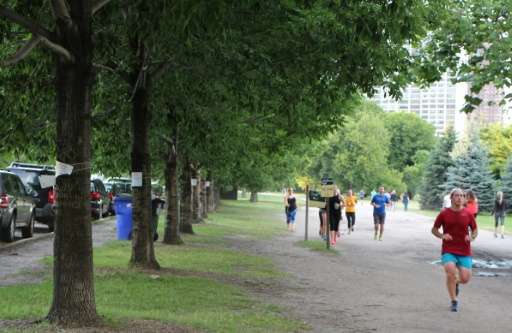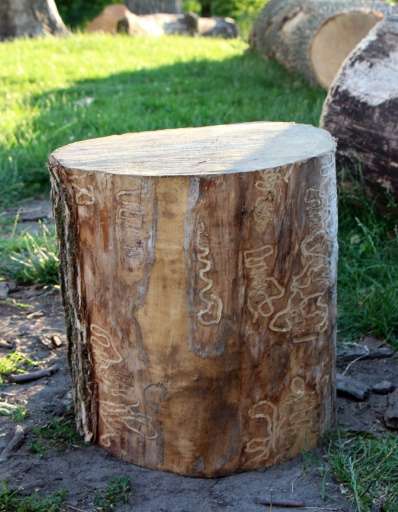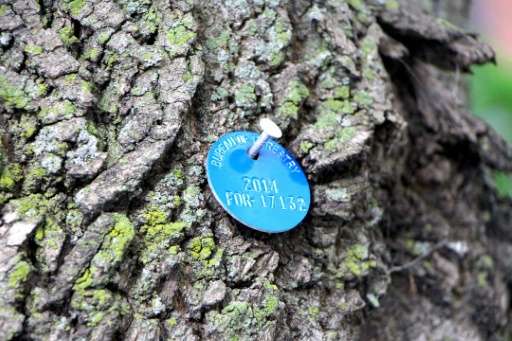Tiny Asian beetle wreaking havoc on North America's ash trees

Over the next two years, grounds crews in St. Louis will cut down nearly one out of every five trees, altering the US city's leafy landscape for at least a generation.
The Midwestern metropolis made the tough decision with the knowledge that if it does not cut down the trees, most will quickly die.
St. Louis is the latest victim of the Emerald Ash Borer, an Asian beetle smaller than a penny, which emigrated from China via shipping materials and is destroying millions of trees in North America.
The insect targets the Ash tree—a common variety in Midwestern cities, where the tree can survive cramped sidewalks, harsh winters and road salts used to keep streets clear of ice and snow.
In St. Louis, city forestry commissioner Skip Kincaid is tasked with dealing with the invasive pest and the destruction it is expected to cause in the next few years.
"I'm trying as best I can to enlighten the public about how devastating it is going to be," Kincaid said.
To head off the Emerald Ash Borer's advance, Kincaid will cut down almost all of the city's 14,000 Ash trees—or roughly 17 percent of all trees—over the next two years.
Scientists have discovered a pesticide treatment that can keep the insect from killing trees. But Kincaid said that wasn't an economically feasible solution, as it must be repeatedly applied every other year.
The forestry expert surveyed the value of each tree, quantifying the benefits they provide in terms of property values, reducing storm water runoff, and reducing energy costs through natural cooling.
Only 1,000 made the cut.
The rest will be removed and replaced with a variety of species, but it will be years before they reach the size of the Ash trees.
"This is something where quite honestly, we really have no other choice," Kincaid said.

A 'devastating' bug
Noel Schneeberger, a US Forest Service expert at the forefront of the beetle battle, says once the Emerald Ash Borer infests an Ash, the chances of it surviving are basically nil.
"In terms of targeting a single genus of trees, it's pretty devastating," Schneeberger said.
Officials have tried regional quarantines to keep the bug from spreading. But barring the transportation of firewood—thought to be the primary way the bug spreads—has not worked.
Scientists estimate that about 30 million trees have already succumbed to the beetle, and by the time its path of destruction concludes, hundreds of millions more will be dead, brittle, and ready to fall during a storm.
What perplexed scientists at first was that the Emerald Ash Borer is a relatively benign beetle in its native East Asia—where Ash trees have evolved with the insect.
It makes so little fuss in Asia that when it arrived in North America, scientists were not even able to identify the strange insect.
In East Asia, the bug only seems to attack Ash trees that are already sick or dying. Healthy Ash appear to have a natural chemical resistance.
But a vast majority of Ash trees in North America do not, and the bug has been spreading unchecked since its arrival on the continent in 2002. It has reached 26 US states, as far south as Texas, and north into Canada.
In one experiment, scientists were able to induce North American Ash trees into producing compounds necessary to kill the beetle. The question of whether such efforts can be used en masse remain to be answered.

Fighting the insect
The infestation has been particularly devastating for many cities in the Midwest, where streets can have rows of Ash trees for blocks at a time.
The insect burrows into an Ash tree, creating tunnels that completely destroy the tree's ability to move nutrients through its bark. The destruction is so thorough that the tree usually starves to death in less than five years.
The US Forest Service labels the beetle "the most devastating forest insect to reach North America in modern times."
Still, over the last 14 years, scientists have made progress in learning more about the beetle, the tree variety it targets, and about other previously unknown insects.
Through trial and error, they discovered that a coordinated response can keep trees alive. Heavily infested trees should be removed and healthy trees treated with certain pesticides applied every two years.
St. Louis is following a similar plan—focusing on the healthiest and biggest trees, and getting rid of the rest.
"St. Louis has probably the approach that is used most commonly across the country," said Richard Hauer, a professor of urban forestry at the University of Wisconsin who has been helping cities deal with the problem.
How to co-exist
In forests, it's a different story, and scientists are trying to figure out how best to handle the Emerald Ash Borer now that it has moved in.
For one, woodpeckers seem to love to eat the beetle's larvae. They are proving a natural predator, but the plucky birds can't do the job by themselves. Researchers found that they eat only about 16 percent of all Ash Borer larvae.
In China, scientists found other natural predators previously unknown to science—small parasitic insects which are relatives of ants and wasps. Working together, the parasites can reduce the beetle's populations dramatically—anywhere from 50 to 90 percent.
Scientists have begun controlled releases of the parasitic insects in North America, and are studying whether they can create a biological balance of sorts, to reduce the Ash Borer population and keep more trees alive.
But any hope that millions of trees can be saved is a false one, as the parasite controls are in their "infancy," Hauer said.
"Give it several decades, or a century," he said, pointing out that biological controls for previous deadly infestations have taken 50 years or more to have an effect.
In cities, one of the key lessons to take away from the Ash Borer invasion, is that too much of one tree is not a good thing, Kincaid said.
In St. Louis, he is planning to replace Ash with a far greater diversity of trees, so that no one insect can wreak mass havoc again.
"We're in a world now where every year, it's a different invasive pest," Kincaid said.
"That's why it's critical to have this diversity of species. So if something moves in... you won't wipe out 17 percent of your street trees."
© 2016 AFP


















